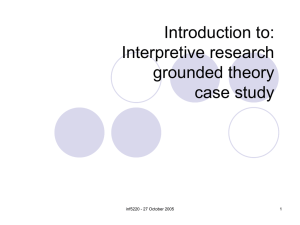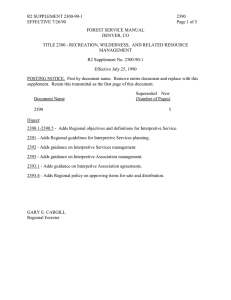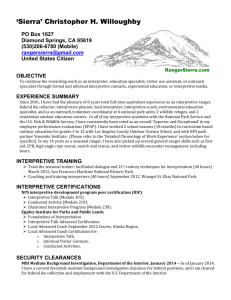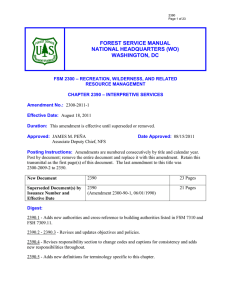CONCEPTS AND DEFINITIONS
advertisement
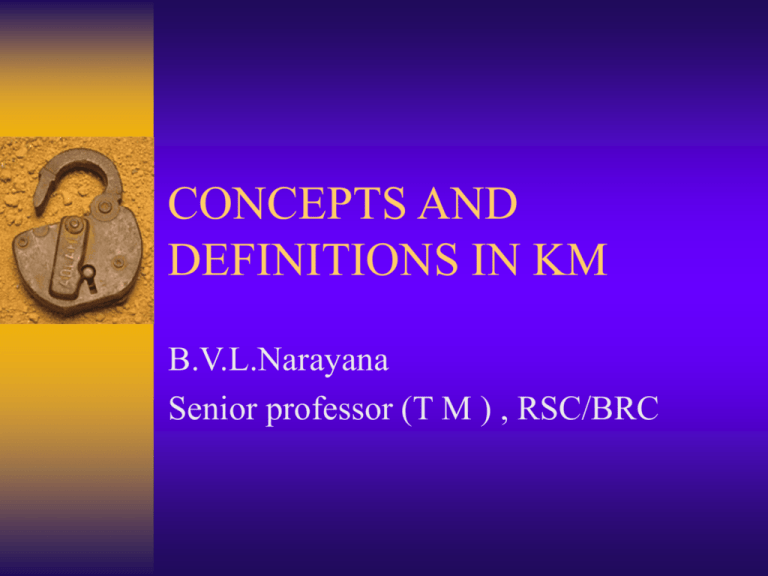
CONCEPTS AND DEFINITIONS IN KM B.V.L.Narayana Senior professor (T M ) , RSC/BRC Basic building blocks (Sanchez 2001) Data – is defined as representation of events that people notice and bring to attention of other people in organization. This is a selective representation of events and is determined by individuals interpretive framework Information – is meaning imparted to data by using an interpretive framework by comparing with other data Building blocks Knowledge – is defined as a set of beliefs about causal relationships in world and organizations. Knowledge resides in the mind of individuals and organizational knowledge is what exists when individuals share the same set of beliefs that enable them to combine and achieve doing something – knowledge is the content created by the process of learning – Know how, know why and Know what Building blocks Learning – is the process that results in change of knowledge and so changes the interpretive framework – Learning is the process of creating knowledge – Learning is acquiring new knowledge, behaviors, skills, values, preferences or understanding, and may involve synthesizing different types of information. Progress over time tends to follow learning curves.Learning is also defined as semi-permanent change in behavior (Wikipedia) – Is self limiting due to convergence of beliefs— decreases future adaptability Building blocks Utility is what value it has for an individual. Interest is a function of utility. To learn a thing and convert it to capability, one needs access to the item. A piece of knowledge or data comes to attention either by active search or through serendipity. What is the utility value of any piece of knowledge/ data? Building blocks Sense making is the process of processing events and forming expectations about significance of such events An interpretive framework is an existing set of beliefs about causal relationships against which we compare current events Building blocks Skills are abilities by which an individual does things. Competency is a set of skills that an individual can use in doing a given task. Capabilities are repetitive pattern of actions that an organization uses to get things done. organizational routines are multi-actor, interlocking, reciprocally triggered series of actions-facilitate coordinated repetitive actions and flow from procedural memory – Routinisation removes the cognitive focus from the activities and goes on without appraisal- instrument becomes the purpose itself. Building blocks Organizational knowledge is an effort to understand and conceptualize the knowledge that is contained within organizations (Easterby smith and Lyles 2003) Knowledge management is about creating ways of disseminating and leveraging knowledge in order to enhance organizational performance (Easterby smith and Lyles 2003) Building blocks Organizational learning is the study of learning processes of and within an organization (Tsang 1997) Learning organization is an entity , an ideal type of an organization which has the capacity to learn effectively (Tsang 1997) Know why PLANNING -STRATEGY SKILLS HIGH Socialisation Codification Internalisation Communication Explicitisation TACITNESS IMPLEMENTATION -ACTION KNOWLEDGE Attention Action process LOW Routinisation Feed back correction Know how Cognition LOW Motor action UTILITY VALUE HIGH Building blocks Michael Polanyi (1966) divided knowledge into explicit and tacit. He defined explicit knowledge as which could be codified and transmitted in a formal and systematic language; tacit knowledge which was personal, difficult to convey, and did not easily express itself in the formality. Tacit === explicit : – Role of language, context, – linked to actions, technical Building blocks community of practice (Lave and Wenger 1991) , – define as ‘a system of relationships between people, activities, and the world; developing with time, and in relation to other tangential and overlapping communities of practice’ – is an intrinsic condition of the existence of knowledge. – focuses on the social interactive dimensions of situated learning, – meaning is negotiated through a process of participation and reification – reification is the process of giving form to experience by producing objects(Wenger 1998) – communities of practice are important places of negotiation, learning, meaning, and identity. Building blocks Social capital is referred to as – ‘the sum of the actual and potential resources embedded within, available through, and derived from the network of relationships possessed by an individual or social unit’ (Nahapiet and Ghoshal, 1998,) – goodwill available to individuals or groups. – Its source lies in the structure and content of the actor’s social relations. – Its effects flow from the information, influence, and solidarity that it makes available to the actor – Consists of shared language , narratives; network ties, structure; relations in form of trust, norms, identity Building blocks (Argyris1995) Single loop – – Detection and correction of errors to ensure performance. Requires some behavior change. Reactionary, for routine, repetitive jobs--habits Double loop – happens through change in master programme or habits; higher level learning, change assumptions or interpretive frame works—active learning Duetero learning – How to do single and double loop learning; proactive process of learning, reflect on past contexts of learning Key concepts Cognitive architecture of knowledge (Amin and Cohendet 2004) – The way knowledge is produced , stored, exchanged, transmitted and retrieved influences organization learning Memory and absorptive capacity At organizational level – absorptive capacity refers not only to the acquisition or assimilation of information by an organization but also the organization’s ability to exploit it.(Cohen and Levinthal 1990)—depends on structure of communication and distribution of expertise – Memory is the capacity to store knowledge– in form of procedures, memory of staffers, in embedded systems, in codes, manuals etc

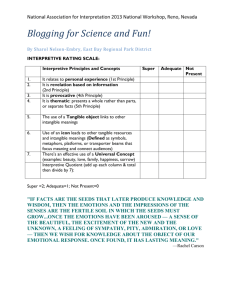
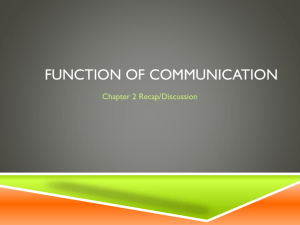
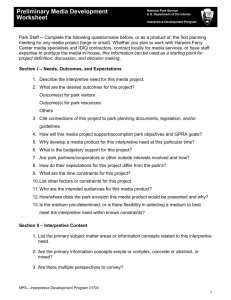
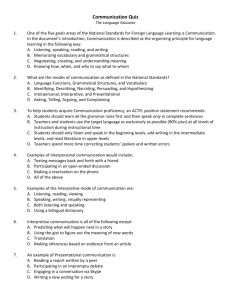
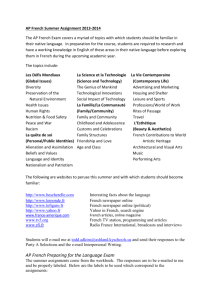
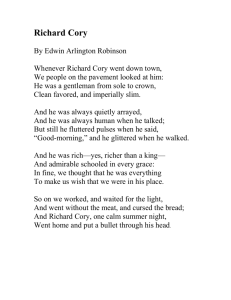
![405 Lesson plan [English 10 Exam prep 2].](http://s3.studylib.net/store/data/009577855_1-d8f6694f6db40f28ef9fe0993a01c806-300x300.png)
